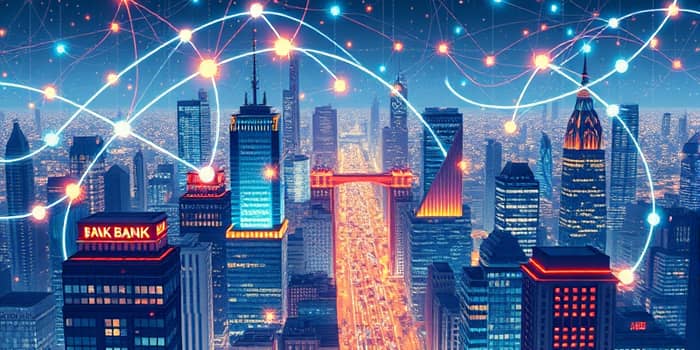In an era where every device can capture and transmit information, the financial services industry stands on the brink of a profound transformation. The Internet of Things (IoT) is no longer a futuristic concept—it is a living, evolving network of sensors and devices reshaping how banks, insurers, and fintech firms operate.
By harnessing vast new sources of granular data from wearables, smart cards, property sensors, and mobile apps, organizations can anticipate customer needs, optimize processes, and unlock novel revenue streams. This article explores the burgeoning market, concrete use cases, key challenges, and the horizon of opportunities that IoT brings to financial insight.
Market Outlook: Growth and Opportunities
The scale of IoT in banking and financial services is staggering. Forecasts predict growth from $0.76 billion in 2025 to $52.16 billion by 2033, reflecting astounding growth rates across segments. Meanwhile, the broader IoT market is set to exceed $1 trillion by 2025 and soar above $3.3 trillion by 2030. By then, over 27 billion devices will be in operation, generating continuous streams of insight.
- IoT in BFSI: $249.4 million (2018) → $2.03 billion (2023).
- Global IoT market: $1.06 trillion (2025) → $3.3 trillion+ (2030).
- Connected devices deployed: 27 billion+ by 2025.
Transforming Financial Services with IoT
IoT-enabled devices capture real-time transaction data streams and environmental metrics that empower financial institutions to:
- Detect anomalies and prevent fraud through holistic fraud monitoring and response networks.
- Deliver predictive financial advice and guidance, crafting personalized service experiences.
- Streamline back-end operations for enhanced edge computing and advanced analytics.
Smart ATMs and connected POS terminals now integrate sensor data to flag suspicious behavior instantly. Wearables and biometric devices add layers of verification, boosting both security and customer satisfaction.
Harnessing Granular Data for Insight
IoT fuels a shift from traditional, intermittent data collection to continuous, real-world intelligence. Mortgage lenders can leverage home sensor readings to adjust interest rates based on property usage, while insurers deploy vehicle telematics for usage-based premiums.
Embedded sensors in products create opportunities for transforming traditional financial product frameworks. From pay-per-use insurance to automated lending criteria, IoT enables “Anything as a Service,” driving dynamic pricing and usage-based billing models.
Financial firms that integrate these insights can refine credit scoring, improve asset valuation, and anticipate macroeconomic shifts with unprecedented precision.
Overcoming Challenges and Risks
With great opportunity comes significant responsibility. The influx of data introduces:
Privacy and security pressures, as devices become prime targets—1.5 billion cyberattacks hit IoT endpoints in 2021 alone. Firms must invest in advanced encryption, device authentication, and real-time threat detection.
Data overload and infrastructure demands, requiring scalable storage, robust cloud solutions, and edge computing to deliver direct integration of financial analytics at the point of interaction.
Model bias and accuracy concerns, as algorithms must sift through noise to generate reliable forecasts. Rigorous data-cleaning, transparent frameworks, and ethical guidelines are essential to mitigate unfair outcomes in credit and fraud decisions.
Key Statistics at a Glance
Future Trends and Emerging Sectors
The horizon of IoT-driven finance includes:
Automated embedded finance experiences—seamless payment and lending services woven into everyday objects.
Usage-based insurance and asset valuation, powered by vehicle and property sensors, promising fairer pricing and risk models.
Expansion into underserved industries: agricultural IoT destined for $6.98 billion by 2025, and automotive IoT ballooning from $397.2 billion in 2023 to $882 billion by 2028.
Conclusion
The fusion of IoT and finance marks a paradigm shift—one where data flows continuously from the physical world into the digital realm of analytics and decision-making. Organizations that embrace this change will not only streamline operations and fortify security; they will craft hyper-personalized services that anticipate needs before they arise.
As stakeholders navigate privacy concerns, infrastructure demands, and ethical considerations, the rewards of unlocking actionable insights are immense. The journey towards a fully connected financial ecosystem has just begun, and its potential to drive growth, innovation, and resilience is boundless.
References
- https://straitsresearch.com/report/iot-in-banking-and-financial-services-market
- https://www.intuz.com/blog/iot-impact-financial-services-industry
- https://sumatosoft.com/blog/impact-of-internet-of-things-iot-on-the-business-economy-trends
- https://softteco.com/blog/how-iot-applications-benefit-industries-today
- https://telnyx.com/resources/future-of-iot
- https://www.mckinsey.com/mgi/overview/in-the-news/by-2025-internet-of-things-applications-could-have-11-trillion-impact
- https://www.valuecoders.com/blog/technologies/top-iot-use-cases-statistics-to-consider/
- https://simetric.com/the-iot-trends-shaping-2024and-whats-coming-in-2025/










